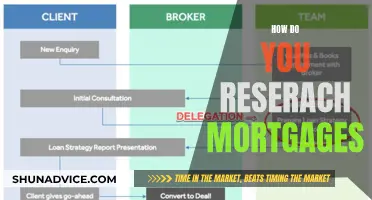
Removing a name from a mortgage is a complex process that requires careful consideration of various factors. It typically involves refinancing, but there are alternative options such as loan assumption, loan modification, mortgage assumption, bankruptcy, or other legal processes. The specific method depends on individual circumstances, including income, credit score, debt-to-income ratio, and the lender's policies. Removing a name from the mortgage deed, or property title, is a separate process and requires filing a quitclaim deed, which transfers ownership and financial responsibility. This guide will explore the steps and challenges of removing a name from a mortgage, highlighting the financial implications and legal requirements to provide a comprehensive understanding of the process.
How to take your name off a mortgage
| Characteristics | Values |
|---|---|
| Ease of process | Not the easiest process in the world |
| Options | Refinancing, loan assumption, loan modification, mortgage assumption, bankruptcy, other legal processes, selling the property, alternative agreements, short sale |
| Costs | Refinancing closing costs: 2-5% of the loan amount; Loan assumption: 1% + processing fees; Loan modification costs vary by lender |
| Time | Closing on a refinance loan: around a month; Filing and recording a new deed: 4-8 weeks |
| Lender | Lender approval required; Lender may request additional documents; Lender decides on the removal option |
| Credit score | A high credit score is required to get a reasonable interest rate as the sole name on the loan |
| Income | Individual income must be high enough to make the mortgage payments on one's own |
| Debt-to-income ratio | Individual debt-to-income ratio must be favourable |
| Paperwork | Requires proof of income, credit history, outstanding debts, etc. |
| Risk | Waiting to refinance carries risks: mortgage interest rates could increase, home values could decrease, late or missed payments will impact both borrowers |
What You'll Learn

Removing a name from a mortgage without refinancing
There are a few ways to remove a name from a mortgage without refinancing:
Loan Assumption
Mortgage loan assumption is often the simplest solution as it doesn't require refinancing. It involves informing the lender that one party is taking over the mortgage and wants a loan assumption. By assuming the current mortgage, the remaining party takes full responsibility and removes the other from the note. However, not all lenders allow loan assumptions, so negotiation is necessary.
Loan Modification
Loan modification allows changing the terms of the mortgage loan without refinancing, typically to lower the interest rate or extend the repayment period. While usually allowed in cases of financial hardship, some lenders may accept divorce or legal separation as a reason for modification. This can be used to transfer the mortgage to the spouse retaining the property. It's important to note that if neither borrower can afford the mortgage on their own, selling the home may be the only option.
Bankruptcy
If the person to be removed from the mortgage declares bankruptcy, their mortgage debt could be discharged, allowing the co-borrower to take sole ownership without refinancing.
Full Repayment
If refinancing is not an option, the lender may insist on fully paying off the loan to remove someone from the mortgage. This finalises the loan and frees all borrowers or co-signers from the agreement. However, this may not be feasible if there is a large amount of debt.
Keeping Both Names on the Mortgage
In some cases, it may be possible to keep both names on the mortgage, especially if both parties continue to live in the house. However, this option carries risks, as late or missed payments will impact both parties.
It's worth noting that removing a name from the deed or retitling the house does not automatically remove them from the mortgage. The mortgage servicer will still hold both borrowers responsible for the debt. To remove ownership rights, the person is likely required to sign a quitclaim deed, and having a divorce decree may make the lender more cooperative. Additionally, removing a name from the mortgage may incur costs, and the lender may request additional documents depending on the situation.
Better Mortgage: Closing Disclosures Simplified
You may want to see also

Taking over the mortgage and removing a name
Taking over a mortgage and removing a name is not a simple process. It is important to understand the difference between removing a name from a mortgage and removing someone's ownership rights. If two names are on the mortgage, both parties are responsible for repaying the loan, but the names on the promissory note determine who has legal ownership of the home.
The most common method of removing a name from a mortgage is by refinancing the loan in the name of the person who will retain ownership of the property. This usually requires closing costs of 2-5% of the loan balance, and it typically takes around a month to close the loan. However, refinancing may not be the best option for everyone, as it may be challenging to qualify for a new loan with only one income and credit profile.
An alternative to refinancing is a mortgage loan assumption, where one person takes on or "assumes" responsibility for the existing mortgage loan. This option does not require refinancing and is allowed by some lenders. A loan assumption may cost around 1% of the loan amount plus processing fees.
Another way to remove a name from a mortgage is through a quitclaim deed, which transfers ownership of the home to a single owner. This process typically takes four to eight weeks to complete and requires the cooperation of the person being removed.
If refinancing or loan assumption is not possible, other options include mortgage modification, bankruptcy, or other legal processes. It is important to consult a lawyer when navigating these complex processes.
Regardless of the method chosen, removing a name from a mortgage typically incurs costs, and it may take several years to qualify for a mortgage independently. It is essential to carefully consider the options and seek expert guidance before making any decisions regarding mortgage debt.
Finding the Best Mortgage: A Shopper's Guide
You may want to see also

Removing a name from the deed
Removing a name from a deed is a different process from removing a name from a mortgage. While a mortgage is a loan liability, a deed is proof of ownership and legal right to property. Therefore, removing a name from a deed will not remove that person's liability to pay back the mortgage loan.
There are two ways to remove someone from a deed, excluding refinancing or selling your home: by mutual agreement or by legal recourse. If either of these scenarios applies, then you can remove someone from a deed by going through a title company and re-recording the deed with the county in one party's name.
However, if you want to remove a name from a mortgage, there are a few options. The most common method is refinancing the loan in the name of the person who will retain ownership of the property. This involves obtaining a new mortgage to pay off the existing one, releasing the other party from their obligation. While refinancing is often the best way to remove someone from a mortgage, it comes with additional closing costs and the potential challenge of qualifying for a new loan.
Another option is to sell the property and pay off or settle the mortgage debt. If neither borrower can afford the mortgage on their own, selling the home may be the only option. This would remove both borrowers from the home loan.
In some cases, you may be able to ask your lender to modify the loan or allow you to assume it for a fee. A loan modification may be used to transfer the mortgage into the name of the spouse who will retain the property. However, not all lenders allow assumption or loan modification, so you will need to negotiate with yours.
If you are unable to refinance and cannot afford to pay off the loan, your lender might insist on selling the home to remove someone's name from the mortgage.
It is important to note that removing a name from a mortgage can be a complex process, and specific steps may vary depending on your lender and location. Consulting a lawyer or a financial advisor can be helpful in navigating these situations.
Removing a Co-Signer from Your Mortgage: A Step-by-Step Guide
You may want to see also

Refinancing a mortgage
Another important consideration is qualifying for a new loan. The lender will assess the financial situation of the individual seeking to retain the property, including their credit score, income, and debt-to-income ratio. It may be challenging to meet the minimum refinance requirements with only one income and credit profile. Additionally, the process of refinancing involves significant paperwork, similar to applying for a new loan.
While refinancing is a popular option, it is not the only way to remove someone's name from a mortgage. Alternative methods include loan assumption, loan modification, and selling the property. Loan assumption allows one person to take over the existing mortgage loan, releasing the other person from the loan. However, not all lenders allow loan assumption, and it may be necessary to negotiate with the lender. Loan modification enables changing the terms of the loan without refinancing, such as extending the repayment period or lowering the interest rate. Divorce or legal separation may be accepted by some lenders as a valid reason for a loan modification.
In some cases, selling the house may be the most feasible option to remove both names from the mortgage. This option provides a fresh start for both parties, especially if neither can afford the mortgage on their own. Additionally, waiting to refinance carries certain risks, such as potential increases in mortgage interest rates or decreases in home values. Therefore, it is essential to carefully consider the timing and explore all available alternatives before making a decision.
Closing Costs: Rolling Them into Your Mortgage
You may want to see also

Selling the property
However, selling the property may not always be a viable option. For instance, if one party wants to keep the home, you will need to explore other alternatives. Additionally, if real estate prices have declined, selling the home could be challenging, especially if you recently purchased the property and made only the minimum down payment. In such cases, you may need to consider other options, such as refinancing, loan modification, or assumption, or paying off the entire mortgage.
If you decide to sell the property, you can start by verifying your refinance eligibility. You can then proceed with the sale, ensuring that you meet the lender's requirements for documentation and providing the necessary paperwork. It is also essential to be aware of any potential capital gains taxes on the proceeds from the sale, especially if you are selling a jointly-owned investment property. Consulting a professional tax preparer can help you navigate these tax implications effectively.
Removing Deceased Spouse from Mortgage: What You Need to Know
You may want to see also
Frequently asked questions
There are several ways to remove a name from a mortgage. One way is to refinance the mortgage in your name alone. Another way is to do a loan assumption, where the remaining borrower takes over the balance of the loan. A third way is to do a loan modification, which changes the terms of the loan.
To refinance a mortgage in your name alone, you will need to re-apply for the loan as an individual. This includes providing proof of income, credit history, and outstanding debts. The lender will then decide whether to approve the refinance based on your individual financial situation.
Loan assumption allows the remaining borrower to take over the balance of the loan, with the original terms of the mortgage (such as the interest rate) staying the same. However, not all lenders offer loan assumption, and there may be closing costs involved. It is important to speak with your lender to see if this is an option for you.







